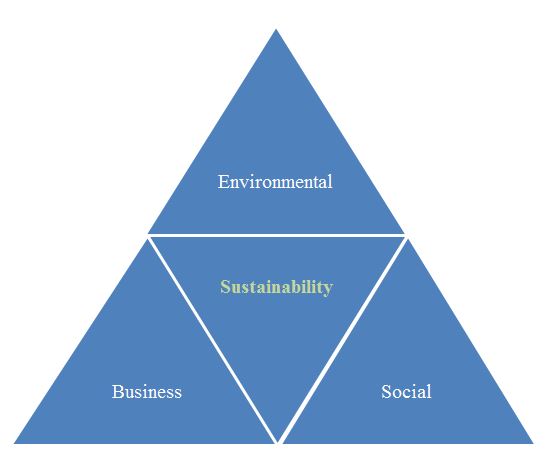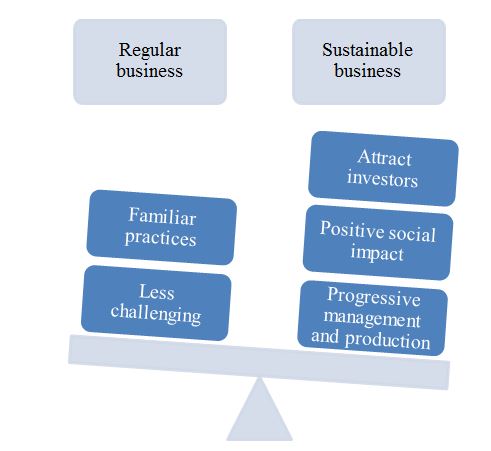Nowadays, more entrepreneurs have started to realize the importance of sustainability implemented in their practices. Compared to the previous decades, companies dedicate a greater amount of time to creating reports about their influence on the socio-economic specters of life and evaluating their effect on society (Walsh, 2021, para. 2). Although the awareness of sustainability keeps growing among the business owners, not all organizations choose to follow this strategy and move towards a new perspective. However, by combining environmental and socio-economic approaches, a company can achieve a more significant competitive advantage in the market.
Environmental Sustainability
Environmental sustainability is most likely the most widespread type since it implies preserving the natural resources in decent condition, which impacts human life as well. Over time people tend to use more planet reserves for their benefit without the proper care of what they leave after taking from it. Environmental sustainability aims to preserve the biological diversity and organic composition of the Earth so that the resources will not finish over time and will maintain their capacity for future generations.

Water and air pollution, excessive litter that cannot be recycled, and plastic in the dumps contribute to the decrease in environmental quality. Each organization is directly connected to it by using natural resources, producing waste, and facing the results of global warming (Lahneman and Hicks-Webser, 2022, para. 5). One of the most common solutions is installing solar panels, using recycled packaging, and managing transportation to minimize carbon footprint. Therefore, it is possible for companies to shift their regular practices toward more ecological approaches in order to address the issue (The Importance of Environmental Awareness When Running a Business, 2022, para. 2). Consequently, it leads to business sustainability and the general concept of it.
Business Sustainability
The central idea of sustainability in business is to maintain flourishing communities while caring for the ecology while working and producing goods. Nevertheless, it is challenging for companies to achieve this goal separately, but cooperation can create the whole circle of minimized waste. For instance, if some supermarket does not sell all the groceries and they are about to rot, they can be delivered to some small business or café that makes smoothies or juices (Bansal, 2022, para. 4). However, some entrepreneurs perceive business sustainability as a threat because they are not ready to make changes and, at the same time, are afraid to lose investments (Holt, 2020, para. 2). Investors nowadays are interested in the companies that stick to the green policy since it creates long-term economic and environmental benefits. Thus, choosing ecological ways of managing the business processes is advantageous and profitable both for the organization and the society.
Social Responsibility
Similarly, the population as a whole and each person individually create an impact on the surrounding world and the state of the planet. In the broader sense, social sustainability means equity, justice, decent living conditions, and fair pay for everyone (Mohamed, Paleologos, and Howari, 2020, p. 27). Additionally, it is connected to the practice of ecological habits and the development of green solutions (Dybdal and Breining, 2020, para. 14). Such simple actions as sorting garbage, using more public transport instead of a car, or stopping buying paper books and starting to read electronic versions altogether create a significant influence. Taking the initiative and promoting a certain lifestyle among the community defines the key point of social sustainability, allowing people personally participate in saving the planet and keeping its resources for future generations.
Combination of Perspectives and Competitive Advantage
Combining all environmental, business, and social perspectives allows a company to create a competitive advantage and take a strong position in the market. Firstly, a company should identify which natural sources it uses the most and estimate the amount of waste and negative outcomes of the production. The environmental approach will help in that case and helps to focus on the most crucial factors. Business outlook, in turn, can analyze the structure of work and production to find aspects that can be improved and modified to the benefit of the ecology (McGuinn et al., 2020, p. 23). Consequently, the organization can cooperate with other companies with similar policies, use renewable energy or make a production from sustainable materials.

A social perspective will give the management a clear view of what people they should hire for work that would share the same values. Moreover, integrating the principle of sustainable development into the corporate culture brings awareness to the employees and forms a certain mindset that will improve work performance. These factors create the institution with a progressive outlook and promote a positive impact on society, which is attractive for the investors.
Conclusion
Overall, a company has a great potential to achieve a competitive advantage in the market by following the three main concepts of sustainability: environmental, business, and social. Altogether, they build a system of values and work ethics that imply the care for the planet, natural resources, and reasonable usage. Organizations have an opportunity to rearrange their work, minimize the cost of production and increase the profit by making current sustainable decisions to preserve the sources for the future.
Reference List
Bansal, T. (2022) What is business sustainability? Web.
Dybdal, L. and Breining, S. N. (2020) What is social sustainability? Web.
Holt, J. (2020) ‘Sustainability in business is more an opportunity than a threat’, Forbes, Web.
Lahneman, B. and Hicks-Webser, C. (2022) Environmental sustainability – meaning, Examples, and importance. Web.
McGuinn J. et al. (2020) Social Sustainability–Concepts and Benchmarks. Web.
Mohamed, A. M. O., Paleologos, E. K., and Howari, F. (2020). Pollution Assessment for Sustainable Practices in Applied Sciences and Engineering. Butterworth-Heinemann.
The Importance of Environmental Awareness When Running a Business (no date). Web.
Walsh, D. (2021) 4 strategies for sustainable business. Web.